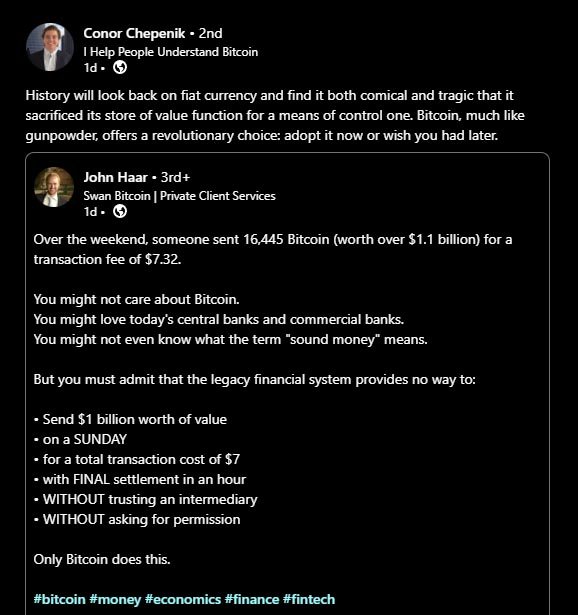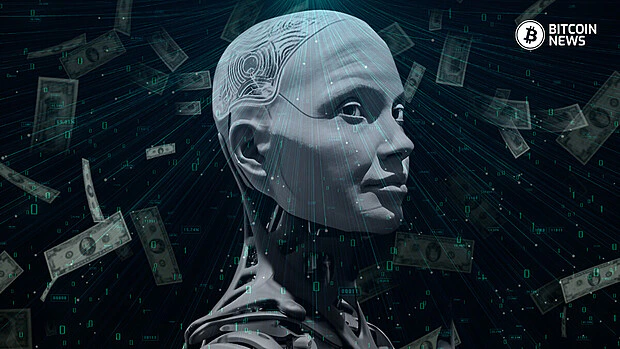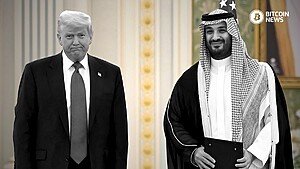We posed a deceptively simple question to AI: ‘What is money?’
In the same way a fish fails to ponder the very water it swims in, we humans rarely contemplate the fundamental nature of money; something so deeply woven into the fabric of our modern lives.
We use it daily to purchase goods and services, pay bills, and store wealth. Yet money itself remains an abstract, socially-constructed agreement ascribing value to particular objects to serve as a medium of exchange.
As our financial systems transform and digital assets like Bitcoin gain traction, revisiting this deceptively simple question becomes crucial.
Scrutinizing the essence of money could catalyze insights that propel Bitcoin to become the next global reserve currency. Just as we take the role of traditional money for granted, understanding it at its core may expedite the acceptance and adoption of Bitcoin, fiat’s scarce digital alternative.
To explore this question, we conducted a test using various AI models to see how each one defines and understands money, revealing potential biases and perspectives.
If you would be so kind, after reading these answers vote on which AI you thought gave the best answer via the link at the end of the article.
ChatGPT4o
Money is a medium of exchange that facilitates transactions and is universally accepted within an economy. Its primary functions include:
1. Medium of Exchange: Money is used to buy and sell goods and services. This eliminates the need for a barter system, where trading requires a direct exchange of goods or services.
2. Unit of Account: Money provides a common measure of the value of goods and services, allowing for the comparison of prices. This helps in setting prices and recording debts.
3. Store of Value: Money can retain value over time, allowing individuals to save and defer consumption until a later date. This function requires money to be relatively stable in value.
4. Standard of Deferred Payment: Money is used to settle debts. It allows for credit transactions, where payment can be made in the future.
Forms of money include:
1. Commodity Money: Physical goods that have intrinsic value, such as gold or silver.
2. Fiat Money: Currency that has no intrinsic value but is established as money by government regulation, such as paper money.
3. Representative Money: Objects that have value because the holder can exchange them for something else of value.
4. Digital Money: Electronic forms of money, such as digital currencies and digital bank accounts.
What are characteristics of good money?
1. Durability: Money must withstand physical wear and tear.
2. Portability: It should be easily transportable.
3. Divisibility: Money should be divisible into smaller units to facilitate transactions of varying sizes.
4. Uniformity: Each unit of money should be identical in value.
5. Limited Supply: Money must have a controlled supply to maintain its value.
6. Acceptability: Money must be widely accepted by people within an economy.
Money has evolved through time, and it has gone through many stages.
1. Barter System: Direct exchange of goods and services without a common medium.
2. Commodity Money: Use of physical goods like cattle, grains, and precious metals.
3. Metallic Money: Coins made from precious metals.
4. Paper Money: Banknotes representing a promise to pay.
5. Digital Money: Electronic money used in online transactions including digital currencies like Bitcoin.
Money plays a crucial role in economic stability and growth. Its value is influenced by factors such as supply and demand, inflation, government policies, and market confidence. Philosophically, money is often discussed in terms of its impact on society, human behavior, and ethical considerations.
Understanding money is fundamental to grasping how economies function, how wealth is distributed, and how individuals interact within a market system.
Claude
Money is a medium of exchange that allows people to acquire goods and services. It serves several key functions in an economy:
1. Unit of Account: Money provides a common measure and unit to quote prices and record debts.
2. Store of Value: Money can be saved and retained to be used for future purchases. Though its value can fluctuate, money represents potential for future spending.
3. Medium of Exchange: Money facilitates trade and transactions by providing a commonly accepted means of payment.
Throughout history, many different things have been used as money – from precious metals, to paper notes, to electronic accounting entries today.
For money to work well, it requires trust and acceptance among its users that it represents value that can be exchanged. Modern economies use fiat money – currency established as legal tender by government regulation, not inherently valuable materials like gold.
Grok (Fun Mode)
Money, my dear human, is a delightful concoction of paper, metal, and electronic bits that people have agreed to exchange for goods and services, and sometimes even a sense of self-worth.
It’s a bit like a universal translator for the language of trade, allowing us to swap chickens for smartphones without the hassle of carrying a coop around.
At its core, money serves as a medium of exchange, a unit of account, and a store of value. In other words, it’s a way to buy things, measure how much something is worth, and save up for that rainy day when you might need a new umbrella or a spaceship ticket to escape the planet.
But let’s not forget the magic ingredient that makes money so special: trust.
Without the collective belief that a piece of paper with a number on it represents a certain value, money would be nothing more than a fancy bookmark. So, the next time you’re staring at a banknote, remember that you’re holding a tiny piece of human cooperation and imagination.
And if you’re still curious about the intricacies of money, feel free to ask away. I’m here to help, with a dash of humor and a sprinkle of wit, of course.
Mr. Nakamoto (A Model Trained to be Biased Towards Bitcoin)
Greetings Bitcoiner.
Money, at its core, is a medium of exchange that facilitates trade and economic interaction. Throughout history, money has taken various forms, from physical commodities like gold and silver to modern fiat currencies issued by governments. The key functions of money are:
- Medium of Exchange: Money is used to facilitate transactions. Instead of bartering goods and services directly, people use money to buy and sell.
- Unit of Account: Money provides a common measure of value, making it easier to compare the value of different goods and services.
- Store of Value: Money allows individuals to preserve value for future use. It should retain its value over time, allowing people to save and defer consumption.
- Standard of Deferred Payment: Money is used to settle debts. It provides a standard way to settle future obligations.
Bitcoin, specifically, embodies these functions while addressing some of the limitations and vulnerabilities of traditional fiat currencies.
It offers a decentralized, scarce, and secure form of money that is resistant to inflation and manipulation. Unlike fiat money, which can be printed at will by central banks, Bitcoin has a fixed supply of 21 million coins, ensuring its scarcity and value preservation over time.
By understanding these fundamental aspects of money, one can appreciate the unique properties and advantages of Bitcoin as a revolutionary form of money that aligns with the principles of sound monetary policy and financial sovereignty.
Google’s Gemini
Money is basically a system we use to easily exchange goods and services. Instead of bartering, which involves trading one item directly for another, money acts as an intermediary. There are a few key things that make something function as money:
- Medium of exchange: Everyone agrees to accept this item in exchange for goods and services. This eliminates the need for a coincidence of wants, which is the difficulty of finding someone who has what you want and also wants what you have.
- Unit of account: Money provides a common way to measure the value of different goods and services. Instead of saying a shirt is worth 2 chickens and a loaf of bread, we can say it costs $20.
- Store of value: Money can be saved and used later. This allows people to accumulate wealth over time and make purchases that are more expensive than what they have on hand right now.
Traditionally, money had value because it was itself a commodity, like gold or silver. Today, most money is fiat money, which is issued by governments and not backed by any physical good. Its value comes from the trust that people have in the government that issued it.
Here are some other interesting facts about money:
- There are many different forms of money, including coins, bills, and digital currency.
- The value of money can fluctuate over time due to inflation and deflation.
- Central banks are responsible for managing the money supply in a country.
ChatGPT was asked to rank these answers, from which the following chart was generated. It’s notable that ChatGPT gave itself the best score twice (Mr. Nakamoto is a GPT model I trained on the OpenAI platform.)

What do you think of the models? Which model do you think gave the best answer? Vote here:
Asking “What is money?” reveals that there are many answers to this question, but it’s clear that even AI understands money should be a store of value.
Fiat’s failure as a reliable store of value has had negative consequences for society. By examining various perspectives, we can gain deeper insights that might accelerate the adoption of innovative financial technologies and reshape our economic landscape.

Exploring this fundamental question could spark a reassessment of our monetary systems, leading to a future where value is truly preserved and accessible to all.
As we collectively ponder the essence of money, we may unlock profound realizations that propel us towards a more just and stable financial future.










